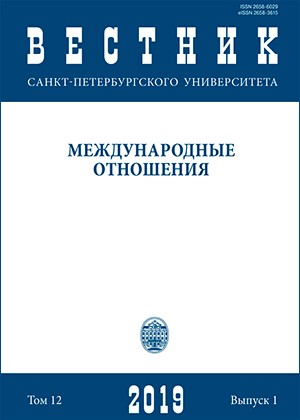China’s strategy toward Central Asia: interests, principles and policy tools
DOI:
https://doi.org/10.21638/11701/spbu06.2019.102Аннотация
In nearly 30 years since the collapse of the Soviet Union, China and the five Central Asian countries have formed a strategic partnership of equal trust and mutual benefit. China’s interests in Central Asia focus on maintaining security in border areas, combating terrorism and extremism, gaining access to stable energy supplies, and expanding overseas markets and investment returns. In the course of its communication with the Central Asian countries, China claims its deep commitment to such principles as peaceful coexistence of all nations, non-use of pressure, military force or threats, mutual respect, refraining from establishing a sphere of influence and promotion of regional peace and development. The main policy tools for China to pursue its grand strategy in Central Asia include properly handling border issues, eliminating potential conflicts, developing good-neighborly and friendly relations with Central Asian countries. In order to achieve mutual benefit and win-win situation, China will continuously upgrade the level of strategic partnership, actively develop economic cooperation and energy cooperation with Central Asian countries. In addition, China will develop comprehensive cooperation with Central Asian countries through the Shanghai Cooperation Organization, balancing the interrelationships with Russia, the United States and other international actors (including some intergovernmental organizations) in Central Asia.
Ключевые слова:
China, Central Asia, national interests, principles of diplomacy, policy tools
Скачивания
Библиографические ссылки
BP Shijie nengyuan tongji nianjian 2016 [BP Energy Outlook: 2016 Chinese Edition]. Available at: https://www.bp.com/content/dam/bp-country/zh_cn/Publications/StatsReview2016/BP Stats Review_2016中文版报告.pdf (accessed: 30.11.2018). (In Chinese)
Zhang Deguang: Shi Shanghezuzhi wei “Dongfang de beiyue” wu renhe genju [Zhang Deguang: “Groundless to View the SCO as the NATO in the East”]. Available at: http://china.rednet.cn/c/2006/06/02/906235.htm (accessed: 01.12.2018). (In Chinese)
Hu Jintao: Gongchuang Shanghaihezuozuzhi gengjia meihao de mingtian — zai Shanghaihezuozuzhi chengyuanguo yuanshou lishihui diliuci huiyi shang de jianghua [Hu Jintao: “Jointly Make A Better Future for the Shanghai Cooperation Organization” — the Speech at the Sixth Meeting of the SCO Council of the Heads of States]. 15th June, 2016. Available at: http://politics.people.com.cn/GB/1024/4477426.html (accessed: 01.12.2018). (In Chinese)
Zhonghuarenmingonghezuo Shangwubu. Duiwai touzi hezuo guobie (diqu) zhinan — Hasakesitan (2017) [The Ministry of Commerce of PRC: the Guidelines of Foreign Investment Cooperation Country (Region) — Kazakhstan (2017)]. Available at: https://www.yidaililu.gov.cn/info/ilist.jsp?cat_id=10148 (accessed: 01.12.2018). (In Chinese)
Zhonghuarenmingonghezuo Shangwubu. Duiwai touzi hezuo guobie (diqu) zhinan — Wuzibiekesitan (2017) [The Ministry of Commerce of PRC: the Guidelines of Foreign Investment Cooperation Country (Region) — Uzbekistan (2017)]. Available at: https://www.yidaililu.gov.cn/info/ilist.jsp?cat_id=10148 (accessed: 01.12.2018). (In Chinese)
Zhonghuarenmingonghezuo Shangwubu. Duiwai touzi hezuo guobie (diqu) zhinan — Jierjisisitan (2017) [The Ministry of Commerce of PRC: the Guideline of Foreign Investment Cooperation Country (Region) — Kyrgyzstan (2017)]. Available at: https://www.yidaililu.gov.cn/info/ilist.jsp?cat_id=10148 (accessed: 02.12.2018). (In Chinese)
Zhonghuarenmingonghezuo Shangwubu. Duiwai touzi hezuo guobie (diqu) zhinan — Tukumansitan (2017) [The Ministry of Commerce of PRC: the Guidelines of Foreign Investment Cooperation Country (Region) — Turkmenistan (2017)]. Available at: https://www.yidaililu.gov.cn/info/ilist.jsp?cat_id=10148 (accessed: 01.12.2018). (In Chinese)
Загрузки
Опубликован
Как цитировать
Выпуск
Раздел
Лицензия
Статьи журнала «Вестник Санкт-Петербургского университета. Международные отношения» находятся в открытом доступе и распространяются в соответствии с условиями Лицензионного Договора с Санкт-Петербургским государственным университетом, который бесплатно предоставляет авторам неограниченное распространение и самостоятельное архивирование.




